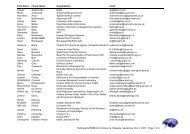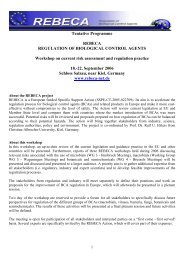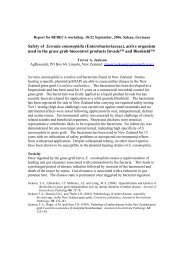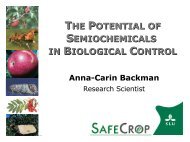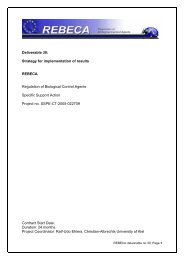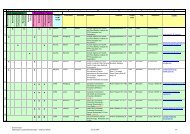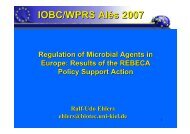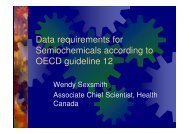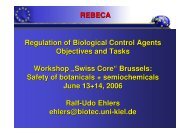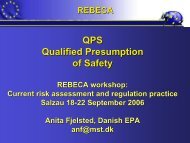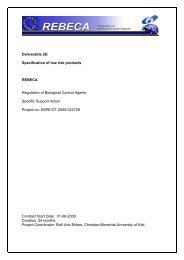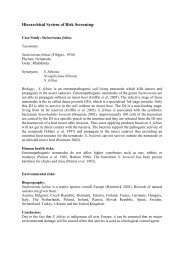EPA: Bacillus subtilis Strain QST 713 (006479) BRAD - REBECA
EPA: Bacillus subtilis Strain QST 713 (006479) BRAD - REBECA
EPA: Bacillus subtilis Strain QST 713 (006479) BRAD - REBECA
- No tags were found...
You also want an ePaper? Increase the reach of your titles
YUMPU automatically turns print PDFs into web optimized ePapers that Google loves.
<strong>EPA</strong>: <strong>Bacillus</strong> <strong>subtilis</strong> <strong>Strain</strong> <strong>QST</strong> <strong>713</strong> (<strong>006479</strong>) <strong>BRAD</strong>885.3200AcuteIntravenousToxicity/PathogenicityAcceptable. No mortality and noadverse clinical signs in rats dosedwith <strong>QST</strong> <strong>713</strong> technical powder.The test microbe cleared from mostorgans by day 35; however, lowlevels detected in spleen and liverafter 35 days.44651908870.2400Primary EyeIrritationAcceptable, Toxicity Category III 44664602870.2500Primary DermalIrritationAcceptable, Toxicity Category IV 44664601870.2600DelayedContactHypersensitivityin Guinea Pigs(<strong>QST</strong> <strong>713</strong>WettablePowder)Acceptable - <strong>QST</strong> <strong>713</strong> WP productdid elicit a very mild delayedhypersensitivity response. Potentialdermal sensitizer446647052. Toxicological ProfileConsistent with section 408(b)(2)(D) of FFDCA, <strong>EPA</strong> has reviewed the available scientific data andother relevant information in support of this action and considered its validity, completeness, andreliability and the relationship of this information to human risk. <strong>EPA</strong> has also considered availableinformation concerning the variability of the sensitivities of major identifiable subgroups of consumers,including infants and children.A battery of tests determined that <strong>QST</strong> <strong>713</strong> Technical product is not pathogenic and has nosignificant toxicity. The acute oral toxicity/pathogenicity, acute pulmonary toxicity/pathogenicity, andacute intravenous toxicity/ pathogenicity studies demonstrated no significant toxicity and a lack ofpathogenicity. The dermal toxicity and eye irritation studies resulted in a Toxicity Category IIIclassification. The acute dermal irritation study resulted in a Toxicity Category IV classification.<strong>Bacillus</strong> <strong>subtilis</strong> is a ubiquitous organism in the environment and there have been no reports of theorganism affecting the immune system. The submitted toxicity/pathogenicity studies in rodents with<strong>Bacillus</strong> <strong>subtilis</strong> strain <strong>QST</strong> <strong>713</strong> indicated that following several routes of exposure, the immunesystem is still intact and able to process and clear the active ingredient. As would be expected for anymicrobial pesticide, <strong>QST</strong> <strong>713</strong> did elicit a very mild delayed hypersensitivity response and isconsidered a potential dermal sensitizer. Further, although it is not known whether strain <strong>QST</strong> <strong>713</strong>does, the species is known to produce the enzyme <strong>subtilis</strong>in which has been reported to produceallergenic or hypersensitivity reactions to individuals repeatedly exposed to the enzyme in industrialsettings. The use of personal protective equipment required for applicators and other handlersmitigates the hypersensitivity risk by minimizing exposure. No hypersensitivity risk is expected fordietary exposure due to the low likelihood that any significant residues will occur on treated food.3. Aggregate Exposuresfile:///J|/<strong>REBECA</strong>/Meetings/1.%20Conference/<strong>REBECA</strong>%...up%20work%20bacteria%20fungi/epaprintonly.cgi.html (8 von 29)13.09.2006 18:40:13



